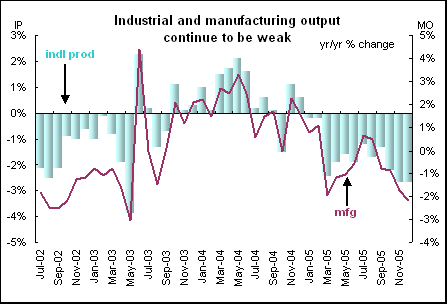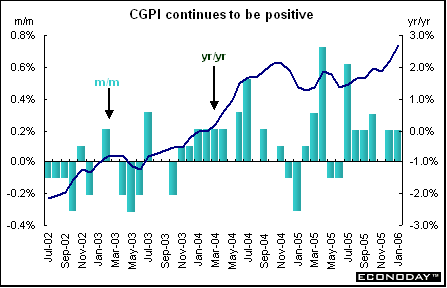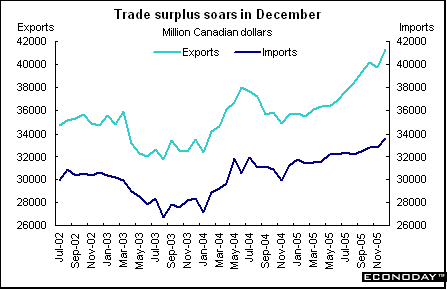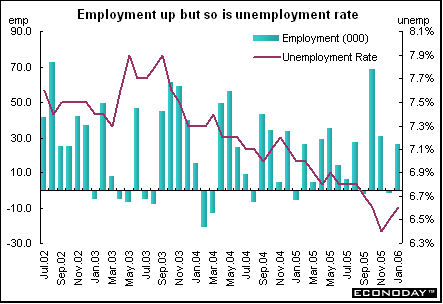Equity markets absorbed for the most part a late week drop in energy and metals prices except in Canada where investors sold. Investors elsewhere continued to digest quarterly earnings while also evaluating prospects for global interest rates. Oil prices were hit by an unexpectedly large increase in U.S. petroleum inventories. In Europe, stocks were helped by merger and acquisition possibilities. But Japanese stocks were volatile, bouncing up and down before ending lower on the week. The yen was the star performer on the currency markets amid speculation that the Bank of Japan could soon begin to tighten monetary policy. That view was bolstered by the release of a strong set of machinery orders data, which underlined the vitality of the Japanese recovery. On the week, eight of the 13 indexes followed here were down on the week.
Global Stock Market Recap

Europe and the UK
Thanks mostly to Thursday's rally, the DAX and FTSE managed to end the week above last week's close. On Thursday, the FTSE gained 1.5 percent and the DAX 1.4 percent while the CAC trailed with 1.3 percent. But on Friday, profit taking and a continued softening of oil and metal prices led to losses for oil and mining stocks. Shares in BP and Royal Dutch Shell were down on the FTSE as were mining stocks such as BHP Billiton and Rio Tinto. BP and Shell account for 18 percent of the FTSE 100 by weighting. In Europe, shares in energy producers such as Total SA were depressed, and technology stocks were hurt by an analyst recommendation to reduce holdings in chip makers. Volkswagen posted an annual profit increase for the first time since 2001 and helped cut Friday's loss on the DAX.

Bank of England - no change
As expected, the Bank of England left its main interest rate unchanged at 4.5 percent for the sixth consecutive month. The Federal Reserve increased the fed funds rate to 4.5 percent on January 31st. The economic news continues to be mixed. A preliminary estimate of fourth quarter GDP was up 0.6 percent on the quarter and the highest in a year. The housing market remained resilient while retail sales volumes showed some life in December. However, manufacturing remains weak and the labor market appears to be slowly deteriorating. The central bank followed its normal practice of making no statement accompanying the decision to leave rates unchanged. Bank of England watchers will have to wait until the minutes of the meeting are released on February 22nd.

Asia/Pacific
Stocks were down in Asia and Australia last week, with the exception of the South Korean Kospi. In Japan, banks and property developers were down after the Bank of Japan said it was getting closer to ending its policy of holding interest rates near zero. On Friday, electronics makers dropped on the prospect that U.S. export demand would soften if, as expected, the Federal Reserve continues to increase interest rates.

In Japan, only a stellar machinery order report Friday mitigated the Nikkei's losses. December seasonally adjusted core private-sector machinery orders jumped 6.8 percent on the year, the strongest gain for five years and well ahead of consensus forecasts. But there were also negatives for the market. The Topix Real Estate index dropped 3.9 percent, the second biggest drop among the Topix's 33 industry groups. Bank shares were down on concern that higher borrowing costs when the Bank of Japan ends its zero interest rate policy would lower demand for loans. On the week, trading in Japanese stocks was volatile - however, sellers outnumbered buyers and stocks were down on the week. Some analysts said that Morgan Stanley's move to reduce its weighting for Japan in favor of the U.S. had a negative effect. Foreign institutions have been the most consistent advocates of the Japanese equity market. But some market watchers blame the volatility on retail investors, who have entered the market in force since the summer, helping drive up share prices.
Bank of Japan awaits inflation
The Bank of Japan maintained the status quo after its two-day meeting. It kept its near zero interest rate policy and continued its quantitative easing. The BoJ kept a target for reserves made available to lenders at between ¥30 trillion and ¥35 trillion. But Governor Toshihiko Fukui indicated the BoJ would seriously consider a policy change at future meetings as consumer prices continue to rise. Fukui said that consumer prices would play a more prominent role in determining the appropriate time to end the current quantitative easing policy. Although he said the timing of a policy shift is undecided, his post-meeting comments were his most hawkish so far. The central bank's policy board voted 7 to 2 to keep monetary policy unchanged. In its monthly report, the Bank kept its assessment of the economy unchanged and said a steady recovery is continuing.

RBA sits tight
At its first meeting of 2006, the Reserve Bank of Australia kept its key interest rate unchanged at 5.5 percent for the 11th month as inflation moderated while consumer spending cooled and home building dropped. The RBA has an inflation target range of two to three percent. Fourth quarter CPI was up 2.8 percent when compared with the same quarter in 2004. The interest rate spread between the U.S. and Australia has narrowed to 100 basis points. The RBA only issues a statement with its decision when it changes its policies. The Bank will publish its quarter monetary policy report, which includes commentary on the economy and interest rates, on February 13th. Governor Ian Macfarlane gives his half-yearly testimony to parliament four days later.

Canada
After closing at an all-time high above 12,000 on Monday, stocks retreated with a vengeance as energy and gold prices declined taking energy and raw materials companies that trade in Toronto down with them. On the week, the S&P/TSX composite sank by 2.4 percent.

Currencies
The yen rallied Friday after an economic report indicated that December machine orders jumped. To currency traders this contributes to the growing body of evidence that economic growth continues to improve. That in turn could lead to the end of the Bank of Japan's zero interest rate policy used to fight deflation. The yen has been depressed as the interest-rate spread between Japan and the U.S. and Europe grows. Contributing to yen strength was dollar weakness after a government report showed the U.S. trade deficit widening to $65.7 billion in December, the third-largest ever. Bigger deficits mean more dollars that need to be converted into other currencies to pay for imports.

Indicator scoreboard
Germany - December manufacturers' orders plummeted 1.6 percent but were up 3.6 percent when compared with last year. Domestic orders were down 1.8 percent but up 10.2 percent on the year while foreign orders were down 1.4 percent and dropped 2.1 percent on the year. Orders for basic goods edged up 0.2 percent on the month but capital goods and consumer & durable goods orders were down 2.8 percent and 1.8 percent on the month.

December industrial production excluding construction was down 0.6 percent but up 3.9 percent when compared with last year. Manufacturing output was down 0.8 percent but up 4.7 percent on the year. Capital goods orders sank by 2.4 percent but were up 6.5 percent on the year while consumer goods were down 0.2 percent and were up 0.7 percent on the year.

December merchandise trade surplus declined to €11.4 billion from €14 billion in the previous month. Exports were up 0.8 percent while imports soared 5.8 percent. On the year, exports were up 11.5 percent while imports were 17.4 percent above December 2004 levels. Soaring imports primarily were attributed to oil imports.

France - December merchandise trade deficit was virtually unchanged at €3.1 billion. Imports were up 3 percent while exports climbed 3.2 percent. Import gains were led by consumer and semi-finished goods. Energy imports were down slightly. Exports were enhanced by Airbus sales.

December seasonally adjusted industrial production was down 0.3 percent and down 0.4 percent when compared with last year. Manufacturing output sank 0.7 percent and dropped 1 percent on the year. All sub-sectors were down with the exception of capital goods - they were up 1 percent. Autos plunged 4.5 percent while consumer goods dropped 0.3 percent.

Fourth quarter flash gross domestic product was up 0.2 percent and 1.4 percent when compared with the same quarter in 2004. No details are available with flash releases. Preliminary data will be available in 10 days.

Britain - December merchandise trade deficit narrowed to £4.4 billion. This compares with a deficit of £4.5 billion in November. The surplus on trade in services was £1.7 billion, £0.2 billion higher than in November. The deficit in goods only was £6.1 billion. This was £0.1 billion more than the deficit for November. The deficit on trade in goods with the EU was £2.9 billion, slightly smaller than November's deficit of £3.0 billion. The deficit with non-EU countries widened to £3.2 billion from the deficit of £3.0 billion in November. Excluding oil and erratic items, the volume of exports was up 1.5 percent and the volume of imports was up by 4 percent. For the year as a whole, the deficit on goods and services was £47.6 billion compared with a deficit of £39.0 billion in the previous year. Excluding oil and erratic items, the export and import volumes were up by 9 percent and 6 percent respectively.

December industrial production was up 0.2 percent but down 2.7 percent when compared with last year. On the month, mining and quarrying output increased by 0.6 percent, while energy supply output decreased by 0.5 percent. Manufacturing output was up 0.3 percent but down 2.2 percent on the year. Output was up in nine of the 13 subsectors. The only significant increase was in the chemicals and man-made fibers while the only significant decrease was in the electrical and optical equipment industries.

Asia
Japan - January corporate goods price index (CGPI) was up 0.2 percent and 2.7 percent when compared with the same month a year ago. Prices for petroleum and coal products were up on the month while prices for electrical machinery and equipment were down.

Australia - January employment was up by 1,800 jobs. Full time employment was up by 30,500 while part time employment decreased by 28,700. The number of unemployed increased by 10,900 to 556,800 leading to an increase in the unemployment rate to 5.3 percent from 5.2 percent in December. The participation rate remained at 64.4 percent.

Americas
Canada - December merchandise trade surplus was C$7.69 billion, up from November's C$6.89 billion reading. Exports were up 3.9 percent while imports were up 2.3 percent. December's surplus was the second highest historically, only surpassed by January 2001 when the surplus was C$8.59 billion. Exports to the U.S. were also up 3.9 percent while imports from the U.S. were up 3 percent. Energy exports, which had depressed export growth in November, rebounded 11.2 percent led by an 11.9 percent surge in natural gas shipments to the United States. Crude petroleum exports gained 7.9 percent.

January employment was up by 26,300 while the unemployment rate edged up to 6.6 percent from 6.5 percent in the previous month as more people ended the labour force. Full time jobs were up 16,100 while part time jobs were up by 10,200. The participation rate edged upward to 67.2 percent from 67.1 percent in December. Manufacturing jobs were down by 42,000 while employment in natural resources gained 12,000 in January. Jobs in the private sector were down 16,000 while there was a gain of 42,000 in the public sector.

Bottom line
Market players will be focused on new Federal Reserve Chairman Ben Bernanke's testimony before Congress on Wednesday. No doubt Fed watchers will parse every syllable he utters. Currency traders will try to figure out just how many more times the Fed might increase the fed funds rate which is currently 4.5 percent. Currency traders try to maximize the spread. They borrow in low interest-rate countries (such as Japan and the EMU for example) but invest in those countries with higher interest rates (such as the U.S.).
Most of the indicators that will be released this week are important. The first estimates for fourth quarter 2005 gross domestic product for Japan, Germany and the EMU head the list. In the UK, a slew of important data will be released including the consumer and producer price indexes, retail sales and the labor report.

